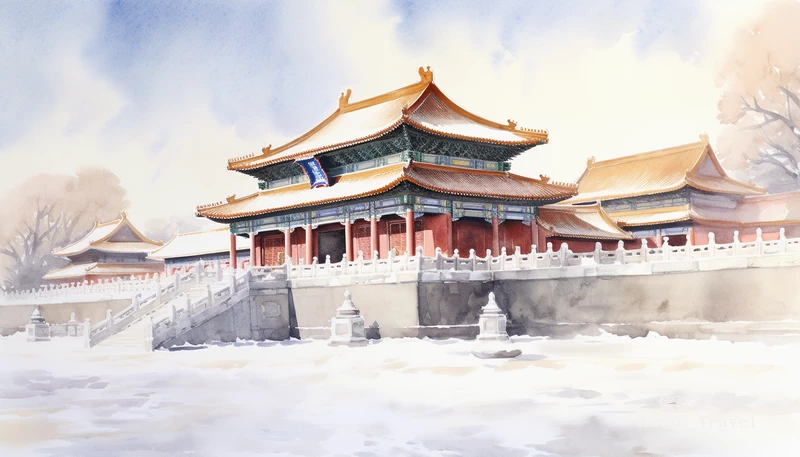Beijing, a city where history whispers from every corner, is a magnificent tapestry of ancient and modern architecture. Home to some of the world’s most awe-inspiring buildings, it offers a unique journey through time. From the grandeur of imperial dynasties to the boldness of contemporary designs, Beijing’s architectural landscape is a testament to its rich cultural heritage.
This guide explores the top 10 most important buildings in Beijing, each a landmark not only in design but also in historical and cultural significance. Embark on this architectural voyage to discover the splendid heritage that shapes the skyline of China’s capital.
1. Hall of Supreme Harmony – the main hall in the Forbidden City (1406)
The Forbidden City, a palatial heart of China, served as the imperial palace for the Ming and Qing Dynasties from 1420 to 1911. At its core is the Hall of Supreme Harmony, an epitome of traditional Chinese palatial architecture. Constructed between 1406 and 1420, this grand edifice witnessed over 500 years of history, encapsulating the essence of political and cultural power of ancient China.
Spanning an area of 72 acres and comprising 980 buildings with 8,707 rooms, it stands as a UNESCO World Heritage site since 1987. The Hall, rebuilt in 1697 after several fires, remains a symbol of imperial authority and architectural marvel, reflecting the profound influence of Chinese design on East Asian culture.
2. Tiananmen Tower – Gate of Heaven Peace (1417)
Tiananmen Tower, the Gate of Heavenly Peace, presents a monumental entrance to the Forbidden City. Constructed in 1417, this iconic structure symbolizes national pride and historical resilience. Stretching 66 meters long, 37 meters wide, and towering 32 meters high, it is adorned with imperial roof decorations, manifesting the grandeur of Chinese architecture.
Visitors can explore the tower for an entrance fee of 20 yuan, offering a panoramic view of Tiananmen Square. The stone lions guarding the gate and the decorative Huabiao columns reflect traditional Chinese protective and aesthetic elements. Walking through the archway beneath the tower, one steps into a passage of history leading to the heart of imperial Beijing.
3. Prayer Hall at Temple of Heaven (1420)
The Temple of Heaven, an Imperial Sacrificial Altar, was a spiritual nexus for Ming and Qing emperors, who prayed for bountiful harvests. Built in 1420, the complex is anchored by the Hall of Prayer for Good Harvest, a stunning circular building resting on a triple-layered marble base.
This 38-meter-tall structure, encompassing a 36-meter perimeter, is a wooden masterpiece, built without a single nail. The Hall is not just an architectural wonder but also a symbol of the harmonious relationship between heaven and earth, as perceived in ancient Chinese philosophy. Designated a UNESCO World Heritage site in 1998, it’s a must-visit for those seeking to understand the spiritual and architectural lineage of China.
4. Great Hall of the People (1959)
The Great Hall of the People, standing on the western edge of Tiananmen Square, is a monumental symbol of modern China’s political landscape. Constructed in a remarkable span of 10 months in 1959, it serves as a venue for legislative and ceremonial activities.
The building, part of the “Ten Great Constructions” celebrating the 10th anniversary of the People’s Republic of China, spans 171,800 square meters. Its grandeur is evident in its dimensions: 356 meters in length and 206.5 meters in width. The national emblem of the PRC hangs proudly at the main gate, reminding visitors of the building’s significance in the heart of China’s capital.
5. Bird’s Nest (National Stadium 2008)
The Beijing National Stadium, affectionately known as the Bird’s Nest, is a marvel of modern architecture and engineering. Constructed for the 2008 Summer Olympics, it left an indelible mark on the global stage with its innovative design.
The stadium’s 26 kilometers of twisting steel make it the world’s largest steel structure, resembling a bird’s nest and symbolizing hospitality. Designed by Herzog & De Meuron Architekten, Arup Sport, and the China Architecture Design and Research Group, this iconic structure can accommodate 91,000 spectators. Today, it continues to attract visitors, not just for its architectural brilliance but also as a lasting emblem of Beijing’s Olympic legacy.
6. National Center for the Performing Arts (2007)
The National Center for the Performing Arts, a futuristic marvel next to the Great Hall of the People, was designed by French architect Paul Andreu and inaugurated in 2007. Its titanium and glass dome, surrounded by a man-made lake, resembles a pearl in the water, earning it the nickname “The Giant Egg.”
The Center houses four major performance halls, including an opera house, music hall, and theater, each designed for specific types of performances. This RMB 3 billion project is not just a hub for cultural events but also a striking example of contemporary architectural artistry in Beijing.
7. China World Trade Center Tower 3 (2008)
Rising 330 meters high with 81 floors, China World Trade Center Tower III is a beacon in Beijing’s business skyline. Completed in 2010, it is the third tallest skyscraper in the city, offering office spaces, a 278-room 5-star hotel, and retail areas. Located in the bustling Central Business District, the tower stands at the intersection of East Third Ring Road and Jianguomen Outer Street.
This towering edifice is not just a commercial hub but also an architectural landmark, reflecting Beijing’s status as a global metropolis and a center of economic activity.
8. Galaxy SOHO (2012)
Galaxy SOHO, an architectural gem in the heart of Beijing, represents a bold departure from traditional design. Completed between 2009 and 2012, this project by Zaha Hadid Architects redefines the concept of office and entertainment spaces.
The structure’s fluid, dynamic forms, devoid of corners or abrupt transitions, offer a 360-degree architectural experience. This complex, comprising office and retail spaces, stands as a testament to modern architectural innovation and creativity, seamlessly blending into Beijing’s historic urban fabric.
9. CCTV Headquarters (2012)
The CCTV Headquarters breaks the mold of traditional skyscraper design with its unique and gravity-defying shape. Designed by Rem Koolhaas and Ole Scheeren of OMA, and constructed in 2008, this 234-meter-high building is a loop of interconnected horizontal and vertical sections.
Situated in Beijing’s Central Business District, it serves as a stunning representation of modern architectural ambition and innovation. The building, a symbol of China’s burgeoning media industry, offers a striking contrast to the traditional architecture of the city, embodying the dynamic evolution of Beijing’s urban landscape.
10. China Zun (2018)
China Zun, towering at 528 meters, is not only Beijing’s tallest skyscraper but also a significant landmark in the global architectural scene. Designed by Farrells, it was completed in 2018 and quickly became a symbol of modern Beijing.
The design, inspired by the ancient Chinese ritual vessel ‘Zun’, reflects the philosophical concept of “heaven is round and earth is square.” Located near the CCTV building, China Zun represents the zenith of contemporary architectural achievement in China and is a must-see for architecture enthusiasts exploring Beijing’s skyline.
Through this top 10 most important buildings’ journey across Beijing, we’ve witnessed the remarkable tapestry of history and modernity that defines China’s capital. Each building, from the ancient grandeur of the Forbidden City to the futuristic elegance of China Zun, tells a unique story of cultural evolution, technological advancement, and artistic vision.
These top 10 most important buildings in Beijing not only stand as icons of architectural brilliance but also as beacons of China’s enduring legacy and its bold stride into the future. As you reflect on these marvels, remember that each structure is a chapter in Beijing’s ongoing narrative, inviting you to explore and appreciate the depth of this extraordinary city.



